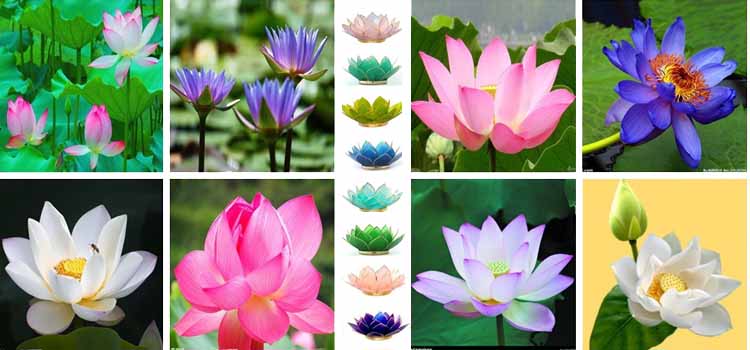In this article, we will discover the meaning of the Lótus flower. Flowers often have various meanings, we have written a large article on our website explaining the meaning of flowers both in the West and in the East.
The lotus flower is a very special aquatic flower in Japan and in some Asian countries like India and Egypt. Its scientific name is Nelumbo nucifera and its history is sacred and has ancient and deep origins. Not only Buddhism, but Hinduism and even the Egyptians consider the lotus flower to be something very important.
The lotus flower is fascinating and incredible because during the night the petals close and the flower submerges underwater. Before dawn, it rises from the depths again, surfacing to reopen its petals. Even the ancient Egyptians associated the lotus flower with the sun god Ra. It is also the only plant that regulates its internal heat, maintaining it around 35ª. Its seeds are also capable of surviving up to 5,000 years without water.

Table of Content
lotus flower in japan
In Buddhism, the lotus flower symbolizes the purity of body and mind, divine birth, and spiritual growth. The lotus flower often blooms over muddy or murky water. Thus, the water is associated withattachment and carnal desires, and the flower above the water is the promise of purity and spiritual elevation.
She is often associated with the Buddha and his teachings. It is believed that when the Buddha (Siddhartha) took his first steps, all the places where the lotus stood blossomed.

Moving a little from the spiritual side, the lotus flower usually represents elegance, beauty, perfection, purity and grace. It is a flower that represents a lot of feminine attributes.
This flower often appears as a reference in several works of literature, including manga, novels and anime.
The Meaning of Lotus Flowers by Color
The lotus flower, a symbol of purity and spiritual enlightenment, varies in colors that carry deep and spiritual meanings. Each shade expresses distinct aspects of the mind, spirit, and spiritual journey, especially within the Buddhist context. Let's explore the meanings of each color in detail.
Blue Lotus
The blue lotus symbolizes wisdom and knowledge. Unlike other flowers, it rarely opens completely, symbolizing that the mind never stops growing and developing. This flower represents the victory of the spirit over material senses, highlighting the importance of controlling earthly desires and passions. In Buddhism, the blue lotus is strongly associated with Manjushri, the bodhisattva of wisdom, who is a symbol of intellect and deep consciousness.
Red Lotus
The red lotus is the emblem of the heart and emotions. This flower symbolizes the original nature and purity of the heart, known as hrdya. It represents love, compassion, passion, and other qualities that flow from the heart. It is dedicated to Avalokiteshvara, the bodhisattva of compassion, whose devotion to the purest emotions is reflected in the vibrant color of the flower. When contemplating the red lotus, we are reminded that love and compassion are essential for spiritual fulfillment.
White Lotus
The white lotus is linked to spiritual perfection. It symbolizes total purity and is associated with an immaculate spirit. The white lotus often appears in Buddhist paintings and sculptures, representing a state of enlightenment without blemishes or imperfections. This flower evokes the idea that, just as the lotus emerges untouched from the mud, the mind and spirit can reach a state of perfection regardless of external circumstances.
Pink Lotus
The pink lotus is considered the supreme flower in Buddhism and is often associated with the figure of the Buddha. It represents the spiritual story of the Buddha himself and is seen as the most sacred of all lotus flowers. In religious ceremonies and sacred images, the pink lotus highlights the importance of enlightenment and the ultimate spiritual achievement. Its elevated status in Buddhism makes it a flower of devotion and deep respect.
Purple Lotus
The purple lotus, known as the mystical lotus, has a unique meaning and is primarily represented in esoteric sects of Buddhism. This flower appears with various petals that symbolize the different paths to spiritual enlightenment. Generally, the purple lotus is associated with occult practices and deep meditations, being considered a powerful spiritual tool for those seeking to understand the mysteries of existence and the mind.
Yellow Lotus
Although less associated with Buddhism, the yellow lotus carries meanings related to joy and energy. Its vibrant color is a reminder of the sun and vitality, symbolizing happiness and prosperity. In Western culture, the yellow lotus is a representation of the power of light and enthusiasm, showing that even in darkness, positive energy prevails.
Black Lotus
The black lotus is a more modern concept and is associated with ideas of mystery and dark power. Although it does not exist in nature, the black lotus has become popular in fictions and games, such as in the famous Magic: The Gathering and in the universe of Accel World. Unlike the white lotus, which symbolizes purity and perfection, the black lotus is often used as a symbol of the unknown and hidden forces, showing how modern mythology continues to explore the power of this mystical flower.

The Meaning of Lotus Flowers in Different Cultures
The lotus flower is one of the most symbolic plants in the world, and its deep meaning transcends cultural boundaries. Its elegant image sprouting from the mud and opening its petals above the water's surface makes it a symbol of rebirth, purity, and transformation. However, each culture interprets this flower uniquely, highlighting various spiritual and philosophical aspects.
Meaning in Buddhism
In Buddhism, the lotus flower holds a prominent place and symbolizes the purity of body, speech, and mind. The lotus grows in the mud but remains immaculate and pure, reflecting the possibility of a human being attaining enlightenment even while living in an imperfect world filled with suffering. The lotus is also seen as a symbol of the spiritual path, as each stage of growth of the flower represents different stages of spiritual consciousness. The Buddha himself is often depicted sitting on a lotus flower, reinforcing the association with transcendence and detachment.
Important Examples:
- The different colors of lotus flowers in Buddhism have specific meanings, such as the pink lotus, which represents the Buddha, and the blue lotus, a symbol of wisdom.
- The sacred scriptures mention that when Buda began to walk, lotuses sprouted beneath his steps.
Meaning in Hinduism
In Hinduism, the lotus flower is equally revered and has a spiritual connection with gods like Vishnu, Lakshmi, and Brahma. In the Hindu context, the lotus symbolizes divinity, fertility, and prosperity. One of the most famous images is that of the goddess Lakshmi, the goddess of wealth and prosperity, often depicted sitting or emerging from a lotus, radiating positive energy and blessings.
Other References:
- The concept of "Padma" (Sanskrit word for lotus) appears in many Hindu texts, representing the cosmos and the spiritual heart.
- The lotus also symbolizes creation and creative energy, as in the story of Brahma, who emerged from a lotus that sprouted from the navel of Vishnu.
Meaning in Ancient Egypt
In ancient Egyptian culture, the lotus was a symbol of rebirth and regeneration. Due to the fact that the flower closes at night and opens with the sunrise, the lotus was associated with the cycle of life, death, and rebirth. The Egyptians believed that the lotus was sacred and often included it in funerary artifacts to ensure a new life in eternity.
Symbolism Key:
- The blue lotus was particularly important and was seen as a symbol of spiritual enlightenment.
- The lotus appears in many hieroglyphs and sculptures, highlighting its significance in Egyptian cosmology and mythology.
Meaning in Chinese Culture
In Chinese culture, the lotus symbolizes purity, harmony, and longevity. The philosopher Confucius used the lotus as an example of nobility and resilience, highlighting the flower's ability to maintain its purity even while growing in the mud. The lotus is also a symbol of true love and marriage, especially due to its connection with harmony and virtue.
Traditions and Symbolisms:
- In traditional Chinese painting, the lótus is a popular theme, used to express elegance and virtue.
- The Lotus Festival is a cultural celebration in many regions of China, where the flower is admired for its beauty and symbolism.

Lotus Flower in cuisine
The flowers, seeds, new leaves, and "roots" (rizomas) of the lotus flower are edible. In Asia, its petals are used as decorations, while its large leaves are used to wrap food. Petals, leaves, and rizomas can also be eaten raw, but there is a risk of transmitting parasites. Therefore, it is recommended to cook them before eating.
They are often consumed as tea due to their therapeutic qualities, which range from healing kidney and lung diseases to combating stress and insomnia. The seeds are also rich in starch and can be consumed raw or dried.
The lotus flower seeds symbolize longevity, as they can germinate even after millennia. They are edible and known for their medicinal properties. They can be consumed in the form of popcorn, called makhanas.
Lotus Flower Gardens in Japan
Japan is famous for its floral gardens spread throughout the country, some stand out when we talk about the lotus flower and we will mention a few below:
- Shinobazu Pond, Ueno Park (Tokyo);
- Tsurugaoka Hachimangu Shrine in Kamakura (Kanagawa);
- Sankei-en Garden, in Yokohama (Kanagawa);
- Kodaihasu no sato, in Gyoda (Saitama);
- Izunuma and Uchinuma Lakes (Miyagi);
- Hanahasu Park, Minami Echizen (Fukui);
- Lotus Garden in Yamaga (Kumamoto);
- Heian Jingu Garden (Kyoto);
- Chiba Park (Chiba);
- Shiro-numa Hasu Matsuri (Gunma);
Other references to the Lotus
The "Lotus flower" is also the name of a meditation posture where the practitioner sits cross-legged with the soles of the feet facing up like Shiva and Buddha. In Asian religions, most deities are often depicted sitting on a lotus flower during the act of meditation.
In Hinduism, it is associated as a gift during the creation of the universe. The Egyptians also believe that the flower is related to the creation of the world and the navel of the God Vishnu. Other Egyptian gods such as Brahma and Horus were born from a lotus flower.
The lotus flower is an example for pessimistic people who complain about life. Even if our life is dark, we must strive to maintain a good appearance and fight to rise again into the light. We can keep in mind things like energy, joy, happiness, longevity, perfection, and wisdom. Did you like the article? Did you know about the lotus flower? We appreciate possible shares and comments.
